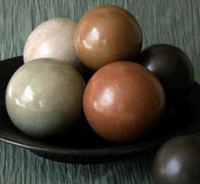Japonica: The Art of Polishing Mud
Polishing rocks is one thing, but mud wouldn’t appear to be hard enough or dense enough to lend itself to being polished. With the application of the right technique and the patience of Job, however, you can do it. Leave it to the Japanese to raise mud balls to high art: Dorodango.
of the right technique and the patience of Job, however, you can do it. Leave it to the Japanese to raise mud balls to high art: Dorodango.
The process couldn't be simpler: you start with a lump of mud, squeeze out most of the water, and slowly and gently add layers of ever-finer dry dirt to the exterior, shaping it into as perfect a sphere as you can by smoothing off any rough spots or irregularities. Over a period of hours, as the ball dries and you continue to work the surface, a hard shell (or “capsule”) is formed.
If you’ve executed and timed the procedure correctly, this crust can be buffed to a high gloss with an ordinary rag. The goal is to create a shiny orb about the size of a billiard ball; its color will result from the kind of soil used, and can vary from nearly white, through yellow, red, and brown, to nearly black, with subtle shadings that make it look like it was carved from the finest marble.
Kyoto University of Education developmental psychologist Fumio Kayo devised a simple method of making dorodango that can be taught even to young children. Professor Kayu’s instructions, including several videos, can be found on his dorodango site. Bruce Gardner, an artist living in New Mexico, shows truly gorgeous globes at dorodango.com; the site includes background information on the art form and helpful instructions for creating your own.
 of the right technique and the patience of Job, however, you can do it. Leave it to the Japanese to raise mud balls to high art: Dorodango.
of the right technique and the patience of Job, however, you can do it. Leave it to the Japanese to raise mud balls to high art: Dorodango.The process couldn't be simpler: you start with a lump of mud, squeeze out most of the water, and slowly and gently add layers of ever-finer dry dirt to the exterior, shaping it into as perfect a sphere as you can by smoothing off any rough spots or irregularities. Over a period of hours, as the ball dries and you continue to work the surface, a hard shell (or “capsule”) is formed.
If you’ve executed and timed the procedure correctly, this crust can be buffed to a high gloss with an ordinary rag. The goal is to create a shiny orb about the size of a billiard ball; its color will result from the kind of soil used, and can vary from nearly white, through yellow, red, and brown, to nearly black, with subtle shadings that make it look like it was carved from the finest marble.
Kyoto University of Education developmental psychologist Fumio Kayo devised a simple method of making dorodango that can be taught even to young children. Professor Kayu’s instructions, including several videos, can be found on his dorodango site. Bruce Gardner, an artist living in New Mexico, shows truly gorgeous globes at dorodango.com; the site includes background information on the art form and helpful instructions for creating your own.
Other resources include:
- Shiny Mud Balls at Web Japan
- Polish your mud balls at 37days
- dorodango-sensei and me at Giant Jeans Parlor
- Dorodango in the Wikipedia





<< Home